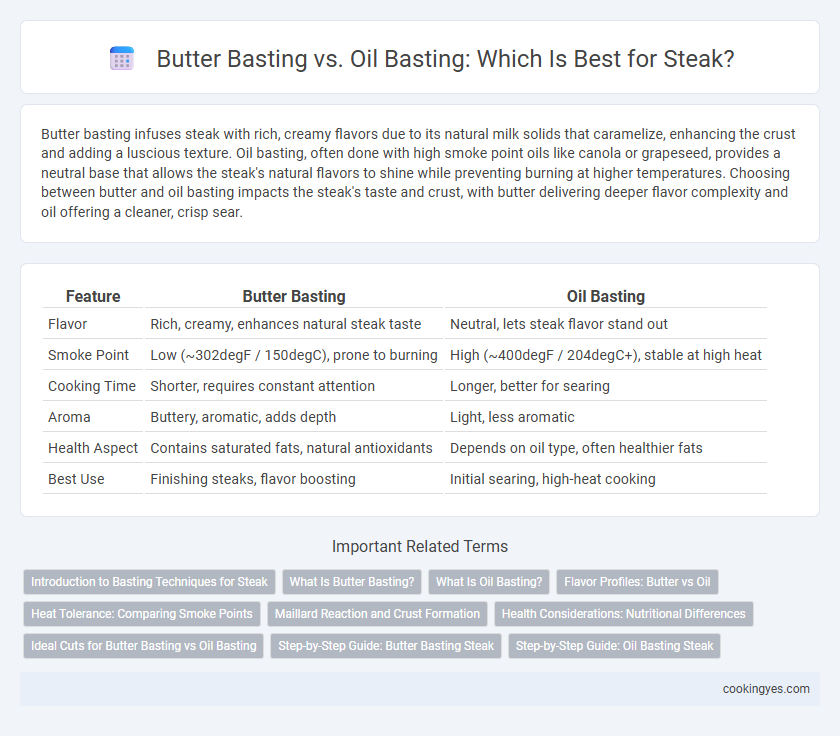Butter basting infuses steak with rich, creamy flavors due to its natural milk solids that caramelize, enhancing the crust and adding a luscious texture. Oil basting, often done with high smoke point oils like canola or grapeseed, provides a neutral base that allows the steak's natural flavors to shine while preventing burning at higher temperatures. Choosing between butter and oil basting impacts the steak's taste and crust, with butter delivering deeper flavor complexity and oil offering a cleaner, crisp sear.
Table of Comparison
| Feature | Butter Basting | Oil Basting |
|---|---|---|
| Flavor | Rich, creamy, enhances natural steak taste | Neutral, lets steak flavor stand out |
| Smoke Point | Low (~302degF / 150degC), prone to burning | High (~400degF / 204degC+), stable at high heat |
| Cooking Time | Shorter, requires constant attention | Longer, better for searing |
| Aroma | Buttery, aromatic, adds depth | Light, less aromatic |
| Health Aspect | Contains saturated fats, natural antioxidants | Depends on oil type, often healthier fats |
| Best Use | Finishing steaks, flavor boosting | Initial searing, high-heat cooking |
Introduction to Basting Techniques for Steak
Butter basting enhances steak flavor by adding rich, creamy notes and promoting even cooking through its milk solids and fat content. Oil basting, often using high smoke point oils like grapeseed or avocado, provides a neutral base that maintains the steak's natural flavor while preventing burning during high-heat searing. Both techniques improve moisture retention and crust development, essential for achieving a tender, flavorful steak.
What Is Butter Basting?
Butter basting is a culinary technique where melted butter is spooned continuously over a steak during cooking, enhancing flavor and promoting even browning. This method infuses the meat with rich, nutty notes from the butter's milk solids while helping to keep the steak moist and tender. Compared to oil basting, butter adds a distinctive depth of taste and contributes to a glossy, caramelized crust.
What Is Oil Basting?
Oil basting involves spooning hot oil over a steak while it cooks, enhancing flavor and promoting even browning by transferring heat efficiently to the meat's surface. Using oils with high smoke points such as canola, grapeseed, or avocado oil prevents burning during the process at high temperatures. This technique helps develop a rich crust and seals in juices, making it a popular method for achieving a perfectly seared steak.
Flavor Profiles: Butter vs Oil
Butter basting imparts a rich, creamy flavor with nutty undertones that enhance the steak's natural beefiness, creating a luxurious mouthfeel. Oil basting, typically using neutral oils like canola or vegetable oil, provides a more subtle, clean taste that allows the steak's inherent flavors to shine without added richness. The choice between butter and oil significantly influences the final flavor profile, with butter offering depth and aroma, while oil emphasizes the pure, seared steak essence.
Heat Tolerance: Comparing Smoke Points
Butter basting offers rich flavor but has a lower smoke point around 350degF (175degC), limiting its heat tolerance during steak cooking. Oil basting with high smoke point oils like avocado (520degF/271degC) or grapeseed (420degF/216degC) allows searing steak at higher temperatures without burning. Choosing oil or butter for basting depends on balancing flavor preferences and desired cooking heat levels.
Maillard Reaction and Crust Formation
Butter basting enhances the Maillard reaction by adding milk solids that brown quickly, creating a richer, flavorful crust on steak. Oil basting, especially with high smoke point oils like canola or avocado, allows for higher cooking temperatures that promote a more even and robust crust formation. Combining butter and oil can optimize Maillard reaction efficiency, balancing flavor complexity with a well-developed sear.
Health Considerations: Nutritional Differences
Butter basting steak introduces saturated fats and cholesterol that may impact heart health, whereas oil basting often uses oils rich in unsaturated fats, such as olive or avocado oil, which are associated with improved cardiovascular benefits. The smoke point of the chosen fat affects nutrient retention and the formation of harmful compounds during cooking. Selecting oils with high smoke points and beneficial fatty acid profiles can optimize the steak's healthfulness while maintaining flavor.
Ideal Cuts for Butter Basting vs Oil Basting
Butter basting is ideal for tender, flavorful cuts like ribeye, filet mignon, and sirloin, as the rich butter enhances their natural juices and adds a caramelized crust. Oil basting works best with leaner, tougher cuts such as flank steak, skirt steak, and chuck, where the higher smoke point of oils helps achieve a seared exterior without burning. Choosing the right fat for basting ensures optimal flavor development and texture for each steak cut.
Step-by-Step Guide: Butter Basting Steak
Heat a heavy skillet over medium-high heat and add a generous amount of unsalted butter once the pan is hot. Place the steak in the skillet and begin spooning the melted butter over the steak continuously, ensuring even cooking and enhanced flavor absorption. This basting technique locks in juices while creating a rich, caramelized crust for a perfectly tender and flavorful steak.
Step-by-Step Guide: Oil Basting Steak
Heat a cast-iron skillet over medium-high heat and add a high smoke point oil such as avocado or grapeseed oil to prevent burning. Once the oil shimmers, sear the steak on each side for 2-3 minutes, then tilt the pan and continuously spoon the hot oil over the top to ensure even cooking and enhanced flavor. Oil basting helps achieve a perfect crust and juicy interior without the risk of butter burning during high-heat cooking.
Butter Basting vs Oil Basting for Steak Infographic

 cookingyes.com
cookingyes.com